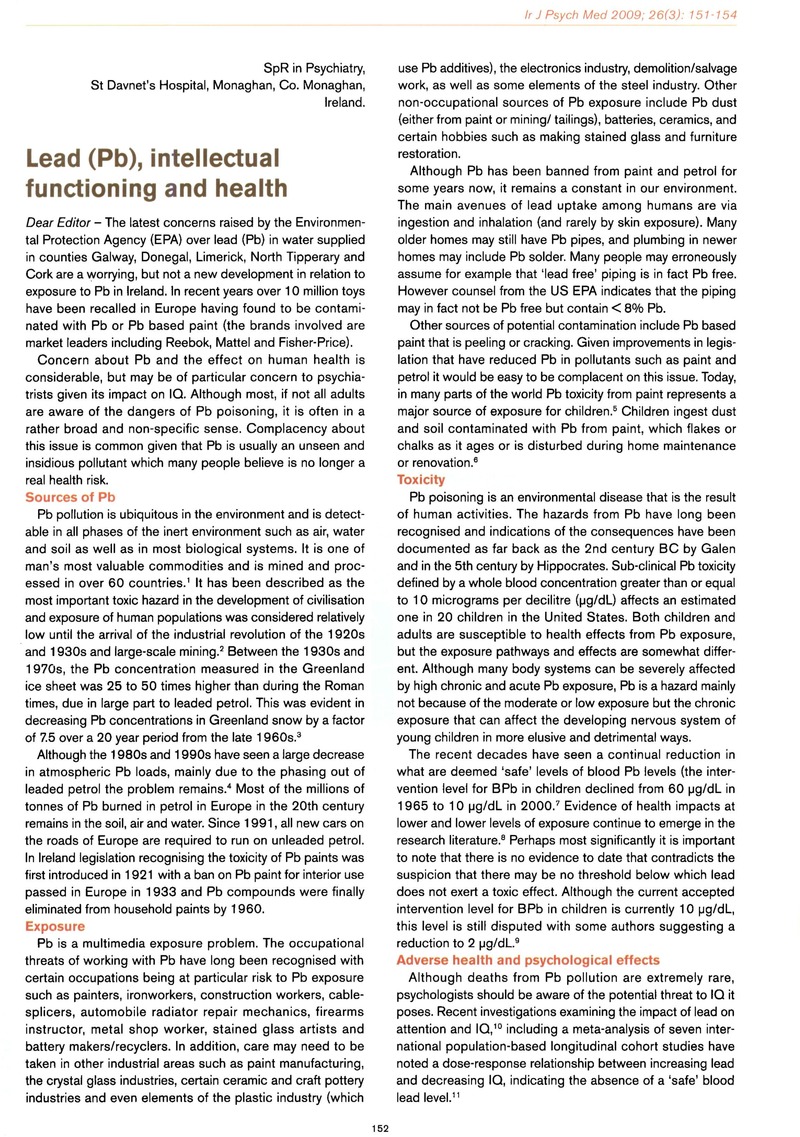No CrossRef data available.
Article contents
Lead (Pb), intellectual functioning and health
Published online by Cambridge University Press: 13 June 2014
Abstract
An abstract is not available for this content so a preview has been provided. As you have access to this content, a full PDF is available via the ‘Save PDF’ action button.

- Type
- Letters to the Editor
- Information
- Copyright
- Copyright © Cambridge University Press 2009
References
1.Thornton, I, Rautiu, R, Brush, S. Lead the facts: An independent report on lead and its industry. London, ICON IC Consultants Ltd, 2001.Google Scholar
3.Boutron, C, Gorlach, U, Candelone, J, Bolshov, M, Delmas, R. Decrease in anthropogenic lead, cadmium and zinc in Greenland snows since the late 1960's. Nature 1991; 353: 153–156.CrossRefGoogle Scholar
4.Boutron, C. Evidence in ice-core research: Proceedings from the Workshop on the Atmospheric Transport and Fate of Metals in the Environment: Antwerp, Belgium, Sept 10 & 11, 1998, International Council on Metals in the Environment, 1998.Google Scholar
5.Lanphear, B, Burgoon, D, Rust, S, Eberly, S, Galke, W (1998(a)). Environmental Exposures to Lead and Urban Children's Blood Lead Levels. Environmental Research 1998; 76: 120–130.CrossRefGoogle ScholarPubMed
6.Lanphear, B, Matte, T, Rogers, J, Clickner, R, Dietz, B, Bornschein, R, Succop, P, Mahaffey, K, Dixon, S, Galke, W. The Contribution of Lead-Contaminated House Dust and Residential Soil to Children's Blood Lead Levels: A Pooled Analysis of 12 Epidemiologic Studies. Environ Res. 1998; 79(1): 51–68.CrossRefGoogle Scholar
7.CDC Screening Young Children for Lead Poisoning: Guidance for State and Local Public Health Officials, US Department of Human Services, Public Health Service, Centre for Disease Control and Prevention, 1997.Google Scholar
8.Canfield, R, Henderson, C, Cory-Slechta, D, Cox, C, Jusko, T, Lanphear, B. Intellectual Impairment in Children with Blood Lead Concentrations below 10 μg/dl. NEJM 2003; 348(16): 1517–1526.CrossRefGoogle Scholar
9.Gilbert, S, Weiss, B. A rationale for lowering the blood lead action level from 10 to 2 g/dL. Neurotoxicity 2006; 27: 693–701.CrossRefGoogle Scholar
10.Chiodo, L, Covington, C, Sokol, R, Hannigan, J, Jannise, J, Ager, J, Greenwald, M. Delaney-Black, V. Blood lead levels and specific attention effects in young children. Neurotoxicol Teratol. 2007; 29: 538–546.CrossRefGoogle ScholarPubMed
11.Lanphear, B, Hornung, R, Khoury, J, Yolton, K, Baghurst, P, Bellinger, D, Canfield, R, Dietrich, K, Bornschein, R, Greene, T, Rothenberg, S, Needleham, H, Schnaas, L, Wasserman, G, Graziano, J, Roberts, R. Low-level environmental lead exposure and children's intellectual function: an international pooled analysis. Environ Health Perspect. 2005; 113(7): 894–899.CrossRefGoogle ScholarPubMed
12.Kaufman, A. How dangerous are low (not moderate or high) doses of lead for children's intellectual development? Arch Clin Neuropsychol 2001; 16: 403–431.CrossRefGoogle ScholarPubMed
13.Kaufman, A. Do low levels of lead produce IQ loss in children? A careful examination of the literature. Arch Clin Neuropsychol 2001; 16: 303–341.CrossRefGoogle ScholarPubMed
14.Bellinger, D. Interpreting the literature on lead and child development: the neglected role of the “experimental system. Neurotoxicol Teratol. 1995; 17(3): 201–212.CrossRefGoogle ScholarPubMed
15.Jedrychowski, W, Perera, F, Jankowski, J, Rauh, V, Flak, E, Caldwell, K, Jones, R, Pac, A, Lisowska-Miszczyk, I. Prenatal low-level lead exposure and developmental delay of infants at age 6 months (Krakow inner city study). Int J Hyg Enviro Health 2007; 211 (3-4): 345–351.CrossRefGoogle ScholarPubMed
16.Fewtrell, L, Prüss-Üstün, A, Landrigan, P, Ayuso-Mateos, J. Estimating the global burden of disease of mild mental retardation and cardiovascular diseases from environmental lead exposure. Environ Res 2004; 94: 120–133.CrossRefGoogle ScholarPubMed
17.Davis, J, Svendsgaard, D. Lead and child development. Nature 1987; 329, 297–300.CrossRefGoogle ScholarPubMed
18.Dietrich, K, Krafft, K, Bornschein, R, Hammond, P, Berger, O, Succop, P, Bier, M. Low-level fetal lead exposure: Effect on neurobehavioural development in early infancy. Pediatrics 1987; 80, 721–730.CrossRefGoogle ScholarPubMed
19.McMichael, A, Baghurst, N, Wigg, G, Vimpani, E, Roberts, R. Port Pirie Cohort Study: environmental exposure to lead and children's abilities at the age of four years. NEJM 1988; 319(8): 468–475.CrossRefGoogle ScholarPubMed
20.Needleman, H, Gastonis, C. Low-level lead exposure and the IQ of children. A metaanalysis of modern studies. JAMA 1990; 263: 673–678.CrossRefGoogle ScholarPubMed
21.Shukla, R, Dietrich, K, Bornschein, R, Berger, O, Hammond, P. Lead exposure and growth in the early preschool child: A follow-up report from the Cincinnati lead study. Pediatrics 1991; 88: 886–892.CrossRefGoogle ScholarPubMed
22.Bellinger, D. Developmental Effects of Lead. Childhood Lead Poisoning: What's New, What's Sadly Not. Children at Risk Conference Environmental Health Issues in the Great Lakes Region, Chicago, Environmental Protection Agency USA, Region 5, 1998.Google Scholar
23.Bellinger, D, Matthews, J. Social and economic dimensions of environmental policy: lead poisoning as a case study. Perspectives in Biology and Medicine 1998; 41 (3): 307–326.CrossRefGoogle ScholarPubMed
24.Lockitch, G. Perspectives on lead toxicity. Clinical Biochemistry 1993; 26(5): 371–381.CrossRefGoogle ScholarPubMed
25.CDC. Preventing lead poisoning in young children: a statement by the Centres for Disease Control. Atlanta, Department of Health and Human Services 1985.Google Scholar




